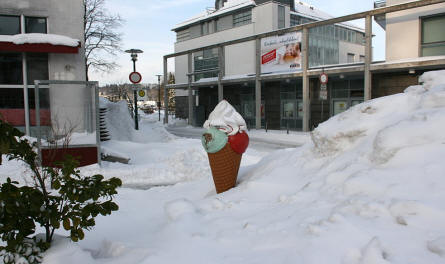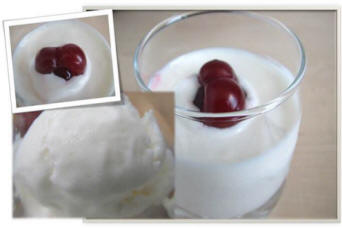By Mary Emma Allen

With
predictions of 6-10 inches of snow arriving tonight and
tomorrow, my thoughts turn to winter traditions, especially
those associated with snow. One of those in our family has been
making ice cream for New Year's Eve or Day. We haul out the
freezer, stir up a custard, then make vanilla ice cream we can
use with various accompaniments-chocolate sauce, crushed
strawberries, raspberries, caramel sauce, or simply plain.
Also, to youngsters of yesteryear, and of my daughter's
childhood, too, blizzard time meant snow ice cream. This treat,
concocted from snow, sugar, milk, and flavorings was one of the
highlights of winter in the days when store-bought ice cream
didn't exist or was a rare treat.
Snow ice cream, handed down from Yankee
ancestors, is a delightful snack at snow time, which appeals to
children and adults. It's best when made from freshly fallen
snow, fine and hard, not wet and soggy, that's scooped from a
big drift where there's no likelihood of scraping soil.
 Snow Ice Cream Preparation
Snow Ice Cream Preparation
You'll find
several methods of making this treat. Choose the one that
appeals to you
Spoon the snow into a large bowl. Over
this pour a custard previously made by mixing together a quart
of milk, an egg, 1 cup sugar, 1/4 teaspoon salt, and 1 teaspoon
pure vanilla extract, cooking until thickened, then cooling to
room temperature.
Snow and custard are put alternately
into the bowl until no more snow can be stirred into the
mixture. The ice cream chills to a delicious thickness, but has
to be eaten quickly before it melts.
Another
Method
This is quicker but doesn't produce such
creamy results. Mix together in a large bowl, a cup of top milk
or cream, 1/2 cup sugar, 1 teaspoon vanilla. Into this stir
snow, as much as can be flavored by the liquid. This also has
to be eaten very quickly for it melts even more rapidly than the
custard type.
As soon as the first snowflakes drifted
down, my siblings and I hoped there would be enough so we could
make this treat.
History of Iced Treats
Recorded history relates that Emperor Nero of
ancient Rome was the first to indulge in a delicacy even vaguely
resembling ice cream. He had swift runners bring snow from the
mountains, which when mixed with fruit juices was not unlike
modern ices.
Another mention of frozen desserts is made
in 13th century annals that Marco Polo brought home to Italy
from Cathay a recipe calling for milk in addition to snow and
juices. From there these frozen treats spread throughout Europe
and were served mainly at the tables of the royal and very rich.